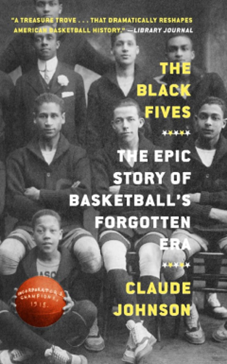The Black Fives. Claude Johnson.
The Epic Story of Basketball’s Forgotten Era.
Not all books live up to their cover or billing. However, there is a lot to like about this “groundbreaking” effort and with that much to glean, process and unpack throughout the journey of reading this “trove” of information. The stories, characters, the events telling the emergence of basketball as a legitimate and popular sport in the northeast and ultimately national landscape while taking shape and form in the late 19th and early 20th century.
While the main topic of this opus is the game of basketball, hence the title The Black Fives, this is every bit as much a tale of black history or American history likely left behind in most school history curriculums. Author Claude Johnson, a historian, a foundation founder and successful business executive, dives deep into the rich history of how and where the game of basketball began to develop a following among the populace including cities such as New York, Washington DC, Pittsburgh and Chicago. Largely unknown or lesser-known names were included as main characters early in the book. Each figure has a major impact on the game and its interest in their respective cities.
The early days of marketing games, recruiting players and the entrepreneurial spirit centering in around the growing game of basketball among white and black crowds and fans alike is very much evident through Johnson’s findings. One memorable example is how basketball games were promoted as part of an evening of a sports spectacle followed by dancing, to the latest in popular music, in the very elegant facilities hosting the event.
One of the upsides of the book is its length and rich historical content. Unfortunately, the downside is also its length and historical content. There is much to glean from all the chapters in this epic. However, this paperback literally packs more than four hundred and twenty pages of tightly woven literature. In fact, one of the reviewing peers asserted that The Black Fives “is a deftly crafted, prodigiously researched” book. Numerous examples of the author taking the reader down rabbit holes and getting farther away from the sport at hand are evident throughout the twenty-nine chapters. Now the book does NOT promise to be solely a sports or basketball laden manuscript. One of the more interesting historical references came early.
Readers are informed as to how the expression “piece of cake” and “take the cake” evolved in anti-bellum times. Later strong connections are made to the origin of the globetrotters of Harlem. Another source of interest was how the famed Rucker league got its start in Harlem as well. Through the authors research we learn that the occupation of delivery person/messenger was a prestigious occupation in early 20th century Manhattan, especially so for young, capable black men.
Perhaps the most striking message of the book, which may or may not have been intended by Johnson, were the many parallels of how basketball teams in the early 20th century were formulated then and how that takes place in college basketball today. Johson wrote about how players were likely to agree to play with one club or franchise during the start of a particular season but very likely switch to another team in the following season, sometimes even switching in the middle of that season as well. To be fair not all these players were collegiate athletes. However, in today’s NCAA basketball, particularly at the highest levels, it is no longer uncommon to see players jump from one school to another while at the height of the transfer portals liberal laws, and abundant Name Image and Likeness payoffs that exist now with few penalties or restrictions.
Another striking topic was the discussion of pay for play versus amateurism. The author asserts that in the early days, even before the NCAA was a governing force of college athletics, strong mindsets were firmly in place in whether players should or should not be played. The book reported that occasionally players would be suddenly disqualified if it were discovered they were on the take, not unlike how NCAA would rule players eligible or not throughout most of the 20th century. Even games were cancelled because of this seemingly flagrant foul which seemed to be a pervasive attitude that the game should be played for the love of basketball and not necessarily personal monetary gain.
Although not a requirement, having a love of the game is a good background to possess before engaging in the four-hundred-and-twenty-page book. Rich in history and intriguing tales of capable men and women, this detailed tapestry demonstrates how a growing, burgeoning nation and popular sport came into clear focus. This was particularly so among the many black pioneers and players the endured eras of discrimination, racism and lesser opportunities. Now we cannot promise this is an easy read or a page-turning affair as getting through the book is a challenge. However, this is also an accomplishment worth the effort to learn more about the forgotten era, and perhaps untold black history for many potential readers, along with the intriguing origin explaining the ascension of black fives around the nation.
· You might like to read this book if you are a basketball or sports fan.
· You might like to read this book if you are fan of black or American history.
· You might like to read this book if you are a fan of early 20th century culture.

Comments
Post a Comment